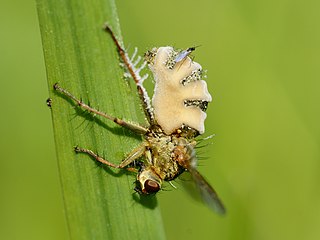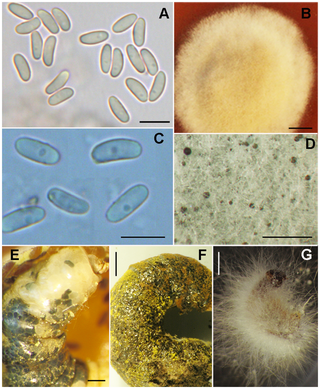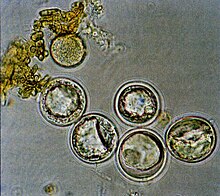
Rusts are fungal plant pathogens of the order Pucciniales causing plant fungal diseases.

Lymantria dispar, also known as the gypsy moth or the spongy moth, is a species of moth in the family Erebidae native to Europe and Asia. Lymantria dispar is subdivided into several subspecies, with subspecies such as L. d. dispar and L. d. japonica being clearly identifiable without ambiguity. Lymantria dispar has been introduced to several continents and is now additionally found as an invasive species in Africa, North America and South America. The polyphagous larvae live on a variety of deciduous and coniferous trees and can cause severe damage in years of mass reproduction. Due to these features, Lymantria dispar is listed among the world's 100 worst invasive alien species.

The forest tent caterpillar moth is a moth found throughout North America, especially in the eastern regions. Unlike related tent caterpillar species, the larvae of forest tent caterpillars do not make tents, but rather, weave a silky sheet where they lie together during molting. They also lay down strands of silk as they move over branches and travel as groups along these pheromone-containing silk trails. The caterpillars are social, traveling together to feed and massing as a group at rest. Group behavior diminishes as the caterpillars increase in size, so that by the fifth instar (molt) the caterpillars are feeding and resting independently.
An entomopathogenic fungus is a fungus that can kill or seriously disable insects. They do not need to enter an insect's body through oral ingestion or intake; rather, they directly penetrate though the exoskeleton.

Orgyia leucostigma, the white-marked tussock moth, is a moth in the family Erebidae. The species was first described by James Edward Smith in 1797. The caterpillar is very common especially in late summer in eastern North America, extending as far west as Texas, California, and Alberta.

The Entomophthorales are an order of fungi that were previously classified in the class Zygomycetes. A new subdivision, Entomophthoromycotina, in 2007, was circumscribed for them.

Nectria cinnabarina, also known as coral spot, is a plant pathogen that causes cankers on broadleaf trees. This disease is polycyclic and infects trees in the cool temperate regions of the Northern Hemisphere. N. cinnabarina is typically saprophytic, but will act as a weak parasite if presented with an opportunity via wounds in the tree or other stressors that weaken the tree's defense to the disease. A study published in 2011 showed that this complex consists of at least 4 distinct species. There are only a few ways to manage this disease with techniques such as sanitation and pruning away branches that have the cankers. N. cinnabarina is not as significant a problem as other Nectria spp., some of which are the most important pathogens to infect hardwood trees.

Massospora cicadina is a fungal pathogen that infects only 13 and 17 year periodical cicadas. Infection results in a "plug" of spores that replaces the end of the cicada's abdomen while it is still alive, leading to infertility, disease transmission, and eventual death of the cicada.

Entomophthora is a fungal genus in the family Entomophthoraceae. Species in this genus are parasitic on flies and other two-winged insects. The genus was circumscribed by German physician Johann Baptist Georg Wolfgang Fresenius (1808–1866) in 1856.

Entomophthora muscae is a species of pathogenic fungus in the order Entomophthorales which causes a fatal disease in flies. It can cause epizootic outbreaks of disease in houseflies and has been investigated as a potential biological control agent.

Lymantria dispar dispar, commonly known as the gypsy moth, European gypsy moth, LDD moth, or North American gypsy moth or spongy moth, is a species of moth in the family Erebidae. It has a native range that extends over Europe and parts of Africa, and is an invasive species in North America.
Lymantria dispar multicapsid nuclear polyhedrosis virus or LdMNPV is a viral infection in spongy moths that causes infected larvae to die and disintegrate. Infected larvae climb to the top of a tree and die. The larvae then melt or disintegrate, falling onto the foliage below, where they infect more larvae.

Entomophaga is a genus of entomopathogenic fungi in the Entomophthoraceae family and also the order Entomophthorales. This has been supported by molecular phylogenetic analysis.

Pandora is a genus of fungi within the order Entomophthorales. This has been supported by molecular phylogenetic analysis.
Entomophaga grylli is a fungal pathogen which infects and kills grasshoppers. It is the causal agent of one of the most widespread diseases affecting grasshoppers. This is sometimes known as summit disease because infected insects climb to the upper part of a plant and grip the tip of the stem as they die; this ensures widespread dispersal of the fungal spores. The fungus is a species complex with several different pathotypes, each one of which seems to be host-specific to different subfamilies of grasshoppers. The pathogen is being investigated for its possible use in biological pest control of grasshoppers.
Ann E. Hajek is an American entomologist with a focus in insect-microbe interactions. She was a professor of entomology at Cornell University from 1994 to 2024.

Ascosphaera aggregata is a species of fungus.
The flora of Door County, Wisconsin comprise a variety of plant species. Geobotanically, Door County belongs to the North American Atlantic Region.
Tarichium is a genus of fungi within the order Entomophthorales of the Zygomycota. This has been supported by molecular phylogenetic analysis.

Furia is a genus of fungi within the family of Entomophthoraceae. This has been supported by molecular phylogenetic analysis.












